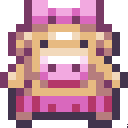What if your game characters had children?
Very often as indie developers we’re responsible for both the game build and game story. And that’s assuming there even is a story in the first place. We don’t typically create “game bibles”, meticulously planned out for months in advance. And other than perhaps doing a sequel, nearly every game we make is treated as if it’s being built in complete isolation from the one that came before. But what if instead of doing this, we linked them together using a “family tree” of game characters, common environments and a shared lore?
For example, say hello to Bob:

Now Bob here could star in his own little piggy platform adventure. Happily running and jumping around. Perhaps he has a special ability like shooting from his snout? Whatever we decide to develop, this becomes Game #1, we publish it and carry on with our next game.
In Game #2 we decide to have a female piggy protagonist called Sally:

This time it’s not a platform game, but a time management one. For the sake of originality (and to help uphold blatant gaming sexism) let’s say Sally is in charge of a diner and must dash around serving the customers. And who should appear as a customer a few times? Yup, it’s Bob, fresh back from his platforming adventures. And as he dines they fall in love, eventually producing:

The star of Game #3 – Tennyson. Now this little chap, being the offspring of Bob and Sally, has inherited the ability to shoot from his shout and dash around at a mad pace. Being the rebellious sort of youngster that he is, he enlists to the Galactic Academy and blasts off into space, blowing the piggy heck out of a violent race of evil alien dudes:

At the end of the shoot-em-up that was Game #3, Tennyson has defeated the onslaught, saved his pet cat and returned back to his home planet older and wiser.
Many years passed while this epic battle was happening and his parents are now getting on a bit. A slightly older Bob has lost the platforming dexterity he enjoyed in his younger days, so now appears in a less stressful Match 3 game (Game #4). Sally has started a small sideline as a detective, exploring the depths of a Hidden Object game (Game #5) where mysterious aliens (remember them?) have been causing havoc.
Not just content with hiding mystic Egyptian symbols in insanely messy rooms, the aliens have more nefarious plans. They kidnap Bob and Sally, and only Tennyson and his sister can save them. Yep, a younger sister. Visually she has a lot in common with her brother and shares similar skills. They battle it out in a Head Over Heels style retro homage, saving the day yet again (Game #6).
Game Lore
Now obviously the above is very tongue-in-cheek. And while we often see the same game characters appearing in different titles there has never been a true genre-spanning lineage or family tree. I would love to get to a point where you could identify a characters family based on its physical attributes alone. Or where the story of the games crosses genres and is self-referencing.
Perhaps the original shoot-em-up that started it all off was just a small part of a much bigger war played out in a later RTS game. Which is referred back to in the storyline of a post-apocalyptic RPG set further down the timeline. Characters you played and interacted with could be talked about as heroes or villans of the past. Their descendants carrying their banner and keeping the family traits alive.
Of course the same story could be played from both sides. There’s no reason why in one set of games you aren’t the “pig family” described above, but in another you play an opposing family of characters set on the other side of the conflict:

I really do feel that there is ample opportunity for game developers like you and I to build this kind of “lore” into our games, regardless of which genres they encompass or the scale of those games. Even if you only make “puzzle games” there’s still a way in which they can be wound together into your own unique IP.
One idea I had a few years ago was for a series of puzzle games that were set as if they would have been board games played by different races in a Tolkein-esque fantasy world. One of the games was a Dwarven version of checkers involving lots of diamonds and gems. Another was an Elven game involving Runes and spell casting.
Essentially they were quite formulaic puzzle games, but linked with a common thread that bound them all together. It doesn’t have to get all meaningful or emotionally complex, you shouldn’t need to explain masses of back-story just to understand the current game. But there’s something very nice and rich about the idea that just like all of your games come from the same place (i.e. your brain and imagination!) so they could actually be set in the same place.
So maybe when planning your next game, no matter what size it is, you may think about how you could keep a tiny bit of continuity going between it and the game that came before it – and the one that will next.
Posted on May 2nd 2012 at 1:15 pm by Rich.
View more posts in Game Development. Follow responses via the RSS 2.0 feed.
Make yourself heard
Hire Us
All about Photon Storm and our
HTML5 game development services
Recent Posts
OurGames
Filter our Content
- ActionScript3
- Art
- Cool Links
- Demoscene
- Flash Game Dev Tips
- Game Development
- Gaming
- Geek Shopping
- HTML5
- In the Media
- Phaser
- Phaser 3
- Projects
Brain Food



